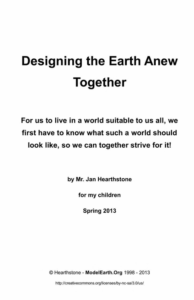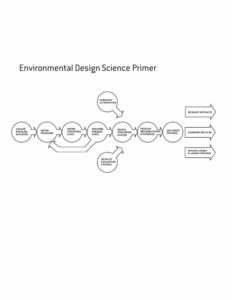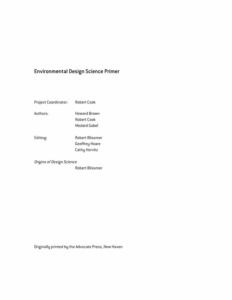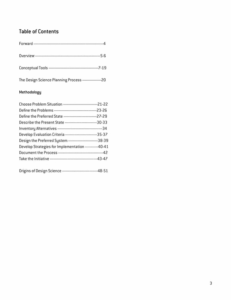Read free. Environmental Design Science Primer, by Howard Brown, Robert Cook, and Medard Gabel, undated.
Excerpt
From the Foreword:
In order to have a significant effect on vital environmental and social issues, people need to acquire the skills that will allow them to act as planners and participants, rather than as spectators in the defining and solving of problems. If environmental education is to be relevant and effective, it needs to balance its approach between activities which alert people to the dangers of a reckless attitude towards the environment, and activities which that inform people how to design and implement positive alternative solutions.
Until recently, concern for the environment has been only a minor factor in the design of the human environment. Even though the environmental sciences have made us increasingly aware of the dangers of unplanned technological growth, trained environmentalists are generally hired by private clients and public agencies to prepare impact statements only after major development projects have been initiated.
Not only is this kind of planning far removed from the general public, little understood and often mistrusted, but the environmentalist’s input into the whole process is several steps away from actual design and implementation of the project. Consequently, those concerned for the environment are relegated the role of lobbing against new technologies or of becoming involved in legal actions to stop or impede further technological development. Design science planning offers an alternative. It is a method by which individuals can clarify their own goals about the future, and develop appropriate technological and institutional alternatives to meet them. In this way, others are encouraged to take the initiative in designing better ways to support human needs.
Introductory Pages
AI Summary
What is Environmental Design Science?
Environmental Design Science is a problem-solving approach pioneered by Buckminster Fuller. It emphasizes using comprehensive, anticipatory design to address humanity’s needs without ecological harm. The goal is to apply science, technology, and whole-systems thinking to create solutions that work for everyone and everything on Earth.
The Core Premise
Humanity has the knowledge and resources to solve problems like hunger, poverty, and energy shortages — but we must design intelligently. This means thinking in terms of systems, understanding consequences, and designing with the whole planet in mind.
Key Concepts
- Whole Systems Thinking: Understand the interconnections between parts of a system to avoid unintended consequences.
- Design Science: Use design as a disciplined tool to solve complex problems and meet human needs.
- Comprehensive Anticipatory Design: Anticipate future challenges and design proactively, not reactively.
- Synergy: Seek solutions that create multiple benefits across different domains.
- Ephemeralization: Do more with less — reduce material and energy use through smart design.
Tools & Methods
- World Game: A participatory simulation game to solve global problems collaboratively.
- Geodesic Domes: Lightweight, efficient structures demonstrating principles of synergy and strength.
- Resource Maps and Inventories: Tools for understanding local and global resources to inform better design decisions.
Philosophy
Design should serve humanity and the planet. Instead of reacting to crises, environmental design science teaches us to create conditions for long-term well-being through thoughtful, integrated solutions.
Why It Matters
Environmental design science shifts the question from “What can I do?” to “What needs to be done, and how can I best contribute?” It encourages people to become designers of their world rather than passive consumers — and to align action with the planet’s ecological limits.
Related Posts

Sustainable Communities

Maker Projects for Kids Who Love…
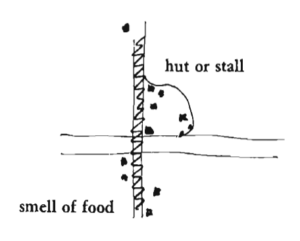
A Pattern Language: Towns, Buildings, Construction
